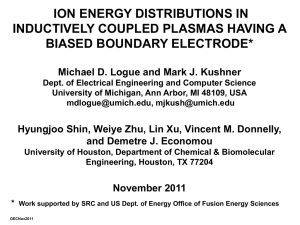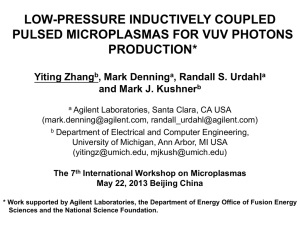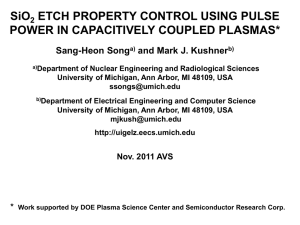JULINE_AVS10_V03 - Mark Kushner Group
advertisement
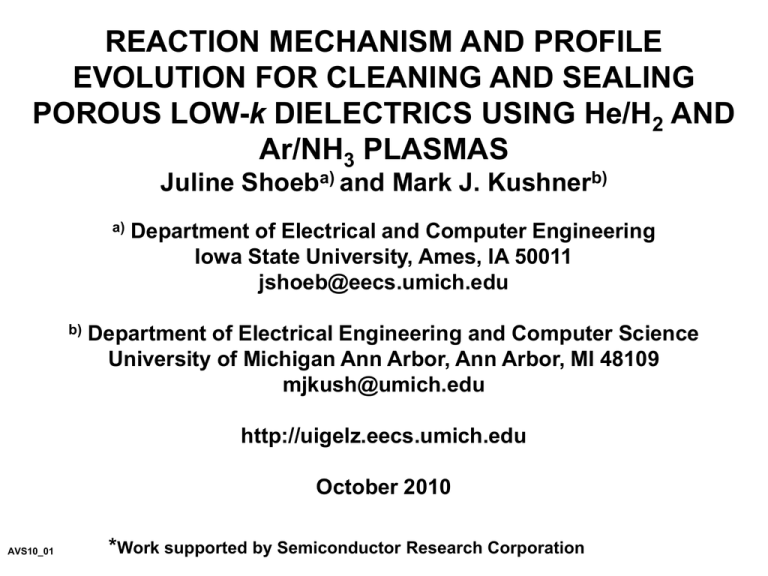
REACTION MECHANISM AND PROFILE EVOLUTION FOR CLEANING AND SEALING POROUS LOW-k DIELECTRICS USING He/H2 AND Ar/NH3 PLASMAS Juline Shoeba) and Mark J. Kushnerb) a) b) Department of Electrical and Computer Engineering Iowa State University, Ames, IA 50011 jshoeb@eecs.umich.edu Department of Electrical Engineering and Computer Science University of Michigan Ann Arbor, Ann Arbor, MI 48109 mjkush@umich.edu http://uigelz.eecs.umich.edu October 2010 AVS10_01 *Work supported by Semiconductor Research Corporation AGENDA Sealing of Low-k Dielectrics Modeling Platforms Generation of Hot H Polymer Removal and PR Stripping In He/H2 Mixtures Sealing Mechanism Using Ar/NH3 Plasma Treatment Sealing Efficiency Pore Radius and Aspect Ratio Pulsing Effect On Etch Rate AVS10_02 University of Michigan Institute for Plasma Science & Engr. POROUS LOW-k DIELECTRICS The capacitance of the insulator contributes to RC delays in interconnect wiring. Low-k porous oxides, such as C doped SiO2 (CHn lining pores) reduce the RC delay. Porosity 0.5, Interconnectivity 0.5. Ref: http://www.necel.com/process/en/images/porous_low-k_e.gif Inter-connected pores open to plasma may degrade kvalue by reactions with plasma species. Desire to seal pores to prevent diffusion into porous network. AVS10_03 University of Michigan Institute for Plasma Science & Engr. LOW-k PROCESS INTEGRATION Typical porous SiO2 has CH3 lineing pores with Si-C bonding – referred to as SiOCH. Ave pore radius: 0.8-1.1 nm Mask Porosity: up to 50% Etching and sealing SiOCH is an integrated, multistep process Porous Low-k SiCOH Si AVS10_04 Etch Ar/C4F8/O2 CCP Clean Activate Ar/O2 or He/H2 ICP He/H2 ICP Seal Ar/NH3 ICP University of Michigan Institute for Plasma Science & Engr. PORE SEALING PROCESS INTEGRATION Step 1: Ar/C4F8/O2 CCP Etch trench leaving PR mask and CFn polymer Step 2: Ar/O2 ICP Remove PR and CFn polymer with O radicals O atoms diffuse into pore network to etch CH3 groups. Degrades low-k material. AVS10_05 University of Michigan Institute for Plasma Science & Engr. PORE PLASMA SEALING MECHANISM Step 3: He ICP Activate surface by sputtering and photodetachment to create dangling bonds. Step 4: Ar/NH3 ICP Seal pores with NHn radicals by forming C-N and Si-N bonds which bridges opening. AVS10_06 University of Michigan Institute for Plasma Science & Engr. He/H2 CLEAN-ACTIVATE Highly motivated to eliminate Ar/O2 step as degradation of SiOCH occurs. Possible alternative is He/H2 ICP plasma cleaning. Hot H atoms (> 1 eV) are produced by dissociative excitation and charge exchange. e H2 H H * e H * Si : CFn Si HF, CHFn , H * Si CH3 Si CH n Hn H* remove PR and CFn while activating surface sites. Low mass of H reduces likelihood for sputter of CHn. Must optimize H* production AVS10_07 University of Michigan Institute for Plasma Science & Engr. MODELING : LOW-k PORE SEALING He/H2 PLASMA Coils Plasma Metal Wafer Porous Low-k Substrate Hybrid Plasma Equipment Model (HPEM) AVS10_08 Energy and angular distributions for ions and neutrals Ar/NH3 PLASMAS Plasma Chemistry Monte Carlo Module (PCMCM) Monte Carlo Feature Profile Model (MCFPM) University of Michigan Institute for Plasma Science & Engr. MONTE CARLO FEATURE PROFILE MODEL (MCFPM) HPEM PCMCM Energy and angular distributions for ions and neutrals MCFPM Provides etch rate And predicts etch profile AVS10_09 The MCFPM resolves the surface topology on a 2D Cartesian mesh to predict etch profiles. Each cell in the mesh has a material identity. (Cells are 4 x 4 A ). Gas phase species are represented by Monte Carlo pseuodoparticles. Pseuodoparticles are launched towards the wafer with energies and angles sampled from the distributions obtained from the PCMCM. Cells identities changed, removed, added for reactions, etching, and deposition. University of Michigan Institute for Plasma Science & Engr. TYPICAL PLASMA PROPERTIES: H2/He ICP Total ion density (cm-3): 1.5 x 1011 Neutral densities (cm-3): H H2 H2(v=1,5) 9 x 1012 7 x 1013 1.5 x 1012 Major fluxes to the substrate (cm-2 s-1): H H2 H2(v=1,3) H+ AVS10_10 6 x 1017 3 x 1018 6 x 1016 2 x 1015 Conditions: H2/He = 25/75, 10 mTorr, 300 W ICP University of Michigan Institute for Plasma Science & Engr. Ar/C4F8/O2 CCP TRENCH ETCH Photo-Resist CCP for trench etch. Ar/C4F8/O2 = 80/15/5 40 mTorr, 300 sccm 10 MHz 5 kW CFx polymer deposited on the sidewalls efficiently seal the open pores. CFx polymers are harmful to diffusion barrier metals such as Ti and Ta. Porous Low-k SiCOH Polymer layers can be removed by: He/H2 plasmas without surface damage. O2 plasmas that etch the CH3 groups. AVS10_11 Animation Slide-GIF Si University of Michigan Institute for Plasma Science & Engr. HOT H GENERATION: He/H2 ICP Vibrational Excitation e + H2(v=0) H2(v=1) +e e + H2(v=n) H2(v=n+1) + e Hot H Generation e + H2(v=n) H** + H** + e Charge Exchange Reactions H2(v=n) + H2+ H2(v=n)** + H2+ H2(v=n) + H2+ H** H + H2+ H2(v=0)** + H+ H2(v=n) + H+ H** H AVS10_12 + H 3+ + H+ H** **Translationally + H 2+ + H+ hot Conditions: H2/He = 25/75, 10 mTorr, 300 W ICP University of Michigan Institute for Plasma Science & Engr. POLYMER REMOVAL AND PR STRIPPING He/H2 plasma used for both polymer (P) removal and photoresist (PR) stripping. PR Hot H, H2, H+ and H2+ remove polymer and masking PR layers as CH4, HF, and CxHyFz H** + P(s) CF + HF H** + P(s) CHF2 H2** + P(s) CH2F2 Porous Low-k SiCOH H** + PR(s) CH4 H2** + PR(s) CH4. CHn groups are also activated by H removal Si H** + CHn(s) CHn-1 + H2. Animation Slide-GIF AVS10_13 **Translationally hot University of Michigan Institute for Plasma Science & Engr. POLYMER REMOVAL, CH3 DEPLETION Ar/O2 plasma efficiently removes polymer. Also removes CH3 groups in pores as O atoms diffuse into the porous network. Low-k SiCOH Net result is increase in pore size. Pore openings can get too large to easily seal. He/H2 plasma removes polymer without significantly depleting CH3. AVS10_14 Si University of Michigan Institute for Plasma Science & Engr. SEALING MECHANISM IN Ar/NH3 PLASMA N/NHx species are adsorbed by activated sites forming Si-N and C-N bonds to seal pores. Further Bond Breaking N/NHx Adsorption M+ + SiO2(s) SiO(s) + O(s) + M M+ + SiO(s) Si(s) NHx + SiOn(s) SiOnNHx(s) NHx + Si(s) SiNHx(s) NHx + CHn-1 (s) CHn-1NHx(s) NHx + P*(s) P(s) + NHx(s) + O(s) + M SiNHx-NHy/CNHx-NHy compounds seal the pores where end N are bonded to Si or C by C-N/Si-N NHy + SiNHx(s) SiNHx-NHy(s) NHy + CHn-1NHx(s) CHn-1NHx-NHy(s) AVS10_15 University of Michigan Institute for Plasma Science & Engr. PORE-SEALING BY SUCCESSIVE He/H2 AND NH3/Ar TREATMENT ·Initial Surface Pores ·He/H2 Plasma Site Activation ·Ar/NH3 Plasma Pore Sealing Surface pore sites are activated by 610s He/H2 plasma treatment. Ar/NH3 plasma treatment seals the pores by forming bridging Si-N, N-N and Si-N bonds. Animation Slide-GIF AVS10_16 University of Michigan Institute for Plasma Science & Engr. SEALING: WITH POLYMER REMOVAL AND PR STRIP He/H2 Activation Sealing Ar/O2 Clean: additional He treatment is required for surface activation, followed by NH3 plasma sealing. He/H2 Clean: Performs both activation and cleaning in a single step. Can seal with NH3 just after the clean. He/H2 Activation Si AVS10_17 Animation Slide-GIF Sealing Si University of Michigan Institute for Plasma Science & Engr. SEALING EFFICIENCY: PORE RADIUS Ar/O2 Clean: Sealing efficiency decreases with increasing pore size. Ar/O2 Clean He/H2 Clean H2/He Clean: Sealing is less sensitive to pore radius. Good Sealing Poor Sealing Animation Slide-GIF AVS10_18 University of Michigan Institute for Plasma Science & Engr. SEALING EFFICIENCY: ASPECT RATIO O2 Clean: sealing efficiency on sidewalls decreases with increasing aspect ratio. He/H2 Clean: sealing does not degrade with higher aspect ratio. Hot H activates all of the surface sites due to its broad angular distribution. AVS10_19 University of Michigan Institute for Plasma Science & Engr. PULSING EFFECT ON PR REMOVAL: He/H2 ICP PR SiCOH Duty cycle reduction increases ion to neutral flux ratios. AVS10_20 Conditions: H2/He = 25/75, A low duty cycle can increase PR removal rate. 10mTorr, 300 W ICP CONCLUDING REMARKS Integrated porous low-k material sealing was investigated Ar/C4F8/O2 Etch H2/He Clean, PR Strip, and Surface Activation Ar/NH3 Sealing He/H2 plasmas clean polymer, strips off PR and activates surface sites in a single step. Higher activation and lower damage seal the surface better. Pulsing can enhance the PR removal rate. Si-N and C-N bonds formed by adsorption on active sites followed by one N-N bond linking C or Si atoms from opposite pore walls. For Ar/O2 clean, sealing efficiency degrades when pore radius is >1 nm and aspect ratio >10. He/H2 clean enables sealing of larger pores and higher aspect ratio trenches. AVS10_21 University of Michigan Institute for Plasma Science & Engr.



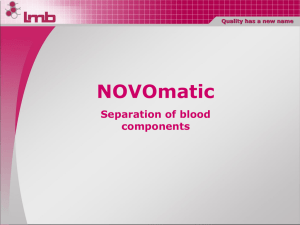
![Wrapping Machine [VP] OPP film wrapping for flat](http://s2.studylib.net/store/data/005550216_1-6280112292e4337f148ac93f5e8746a4-300x300.png)


